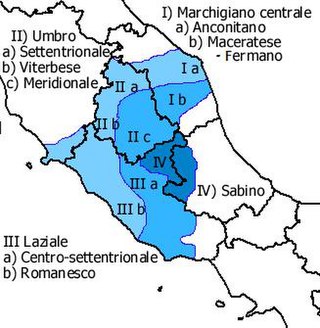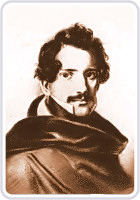Romanesco dialect
This article needs additional citations for verification. (October 2007) |
| Romanesco | |
|---|---|
| Romano | |
| Native to | Italy |
| Region | Lazio |
Native speakers | 3 million[citation needed] |
| Language codes | |
| ISO 639-3 | – |
| Glottolog | None |
| Linguasphere | 51-AAA-rab |
 | |

Romanesco (Italian pronunciation: [romaˈnesko]) is a regional language, or dialect, spoken in Rome. It is a Central Italian dialect and is thus genetically close to the Tuscan dialect and Standard Italian.
There exist a few notable grammatical and idiomatic differences from Standard Italian. Rich in expressions and sayings, Romanesco is used for informal communication by most natives of Rome, often[citation needed] in a mix with Italian.
History

The medieval Roman dialect belonged to the central-southern family, and much closer to the Neapolitan dialect than to the Florentine.[1][2] Typical example of Romanesco of that period is the Vita di Cola di Rienzo, written by a Roman anonymous during the 14th century.[1] Starting with the 16th century, the Roman dialect underwent a stronger and stronger influence from the Tuscan dialect (from which modern Italian derives) starting with the reigns of the two Medici popes (Leo X and Clement VII) and with the Sack of Rome in 1527, two events which both provoked a large immigration from central Italy.[3][4] Therefore, current Romanesco has grammar and roots rather different from other dialects in the Central Italian region.[4]
The path towards a progressive Tuscanisation of the dialect can be observed through the works of the major Romanesco writers and poets of the last two centuries: Giuseppe Gioachino Belli (1791-1863), whose sonetti romaneschi represent the most important work in this dialect and an eternal monument to 19th century Roman people; Cesare Pascarella (1858-1940); Giggi Zanazzo (1860-1911); and Carlo Alberto Salustri (1871-1940), nicknamed Trilussa.
Diffusion
Before Rome became the capital city of Italy, Romanesco was spoken only inside the walls of the city, while the little towns surrounding Rome had their own dialects; nowadays these dialects have almost disappeared and they have been replaced with a kind of Romanesco, which therefore is now spoken in an area larger than the original one, as well as slightly pervading the everyday language of most of the immigrants that live in the city.
Pronunciation
Romanesco pronunciation differs from Standard Italian in these cases:
- the letter J is still used and is pronounced /j/ (like English Y in yes). This letter appears between two vowels or at the beginning of a word followed by a vowel; for instance, Italian figlio /ˈfiʎːo/ "son" becomes fijo /ˈfijo/;
- geminate /r/ ("rolled r" or alveolar trill) does not exist anymore: for example, azzuro /adˈdzuːɾo/; (Italian: azzurro "light blue"), verebbe /veˈɾebbe/ (Italian: verrebbe "he/she would come").[5] A Roman pun recites: "Tera, chitara e guera, co' ddu' ere, sinnò è erore" (Template:Lang-en): note that ere and erore are also "wrong", as they are erre and errore in Standard Italian.[5] This phenomenon presumably developed after 1870, as it was not present in the classical 19th century Romanesco of Belli;[5]
- on the other side, /r/ took the place of Tuscan /l/ before any other consonant: sòrdi /ˈsɔrdi/, Italian soldi "money";
- in Romanesco, as in most Central and Southern Italian languages and dialects, /b/ and /dʒ/ are always geminated when they appear after a vowel: e.g. libbro /ˈlibbɾo/ for Standard Italian libro /ˈliːbro/ "book", aggenda for agenda "diary, agenda".
Noteworthy figures
Today, Romanesco is generally considered more of a regional idiom than a true language. Classical Romanesco, which reached high literature with Belli, has disappeared.
External forces such as immigration and the dominance of Italian are playing a role in the transformation.
Ma nun c'è lingua come la romana
Pe' dì una cosa co' ttanto divario
Che ppare un magazzino de dogana.
"Le lingue der monno"
- G.G. Belli
But there is no language like the Roman one
To express a concept with so many variants
So that it seems a customs warehouse.
"Languages of the world"
- G.G. Belli
Famous Romanesco speakers
This section of a biography of a living person needs additional citations for verification. (September 2014) |
- Ettore Petrolini, actor
- Antonello Venditti, singer
- Aldo Fabrizi, actor and director
- Alberto Sordi, actor and director
- Nino Manfredi, actor
- Anna Magnani, actress
- Gabriella Ferri, singer
- Tomas Milian, actor
- Mario Brega, actor and comedian
- Paolo Di Canio, former footballer
- Gigi Proietti, actor, director and comedian
- Enrico Montesano, actor and comedian
- Carlo Verdone, actor and director
- Sabrina Ferilli, actress
- Francesco Totti, footballer[6]
- Trilussa, poet (Carlo Alberto Salustri's pen name)
- Giuseppe Gioacchino Belli, poet
- Pier Paolo Pasolini, writer, poet and filmmaker
- Cesare Pascarella, poet
- Lando Fiorini, actor and singer
- Franco Califano, lyricist, musician, singer and actor
See also
- Belli's The Sovrans of the Old World (1831)
Sources
- Ravaro, Fernando (2005). Dizionario romanesco (in Italian). Roma: Newton Compton. ISBN 9788854117921.
References
- ^ a b "La Parlata romana" (PDF). online.unistrasi.it. Università per stranieri di Siena. Retrieved 6 February 2015.
- ^ "Romanesco". www.treccani.it. Treccani. Retrieved 6 February 2015.
- ^ D'Achille, Paolo. "Italiano di Roma". www.treccani.it. Treccani. Retrieved 6 February 2015.
- ^ a b "Dialetti". www.treccani.it. Treccani. Retrieved 6 February 2015.
- ^ a b c Ravaro (2003), p. 26
- ^ Agovino, Michael J. (3 September 2011). "In Italy's Serie A, Roma, American Style". NYT. Retrieved 3 September 2011.
External links
- A description of the Roman dialect
- Template:It Lucio Felici, Le vicende del dialetto romanesco, in "Capitolium", 1972 (XLVII), n° 4, pp. 26–33 (it is a summary of the history of Romanesco from the origin to nowadays).
